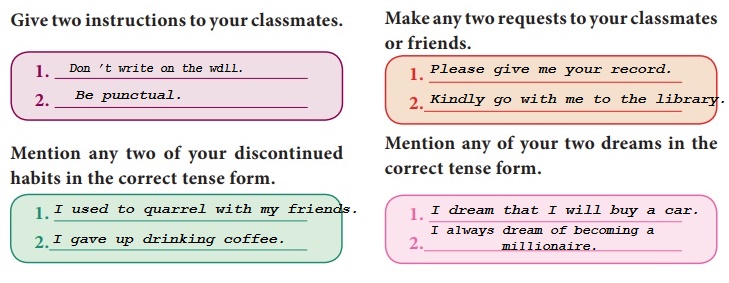English : Unit 3 : Drama : Empowered Women Navigating The World
Glossary
circumnavigate (v) – to travel all the wayaround something, especially the earth
indigenously (adv.) – naturally; innately;inherently
consonance (n) – agreement orcompatibility between opinions or actions
skippered (v) – to act as a master orcaptain of a vessel especially a small boat
expedition (n) – a journey or voyagemade for some specific purpose, such as of war or exploration
replenishment (n) – restoration of a stockor supply to a former level or condition
apprehensive (adj.) – anxious or fearfulthat something bad or unpleasant will happen
contention (n) – strenuous effort;struggling together in opposition
auxiliary (adj.) – additional; used as areserve or substitute in case of need
anticipate (v) – to foresee; to realizebeforehand; to expect; be sure of
bio-luminescence (n) – the production oflight by living organisms
golgappas (n) – the other term for panipuri
morale (n) – emotional or mentalcondition with respect to confidence especially in the face of hardships
WHILE READING QUESTIONS
a. What does INSV stand for?
INSV stands for Indian Naval Ship Vessel.
b. When was INSV Tarini commissioned to Indian Navy service?
INSV Tarini was commissioned to the Indian Navy Service on 18th February 2017.
c. Who is Tara-Tarini? After whom was the sailboat named?
Tara-Tarini is the patron deity for sailors and is worshipped for safety and success at sea. The boat was named after the famous Tara-Tarini temple in Ganjam district of Odisha.
d. Where did the crew undergo their basic training?
The crew underwent their basic training at the Indian Naval Waterman ship Training Centre (INWTC) in Mumbai.
e. How long were they trained to undertake this voyage?They were trained for almost three years to undertake this voyage.
f. Which skill was considered important in the selection process?
The little survival skills they showcased was considered important in the selection process.
g. Who mentored the crew?
The crew was mentored by Commander Dilip Donde.
h. Which quality of the skipper helped to bring out a successful expedition?
Honesty of the skipper helped to bring out a successful expedition.
i. Who among the crew mentioned about teamwork?
Payal Gupta mentioned about teamwork.
j. When did they witness the brilliant Southern lights from the sea? How did the sky appear there?
When they were crossing the Tasman sea, they witnessed the brilliant Southern Lights from the sea. The entire sky lit up in green light.
k. What festival did they celebrate during their expedition?They celebrated Diwali during their expedition.
A. Read the statements given below and state whether they are true or false. If false , then write the correct answer in the space given.
1. Indian Navy’s all-women crew was the first-ever to circumnavigate the globe. – True
2. The crew consists of six members of men and women Indian Navy service. – False
Correct Sentence: The crew consists of six members of women in Indian Navy service.
3. Vartika Joshi skippered the crew to circumnavigate the globe. -True
4. The crew started their expedition on 10 July 2017 from Mumbai. – False
Correct Sentence: The crew started their expedition on i (J September 2017 from Goa.
5. Dilip Donde was the first person to go on a non-stop solo circumnavigation. – True
B. Answer the following questions briefly.
1. Mention the special features of INSV Tarini.
The special feature of INSV Tarini
· It encouraged use of environment friendly non-conventional renewable energy resources such as the wind;
· It collected and updated meteorological, ocean and wave data on regular basis from India Meteorological Department (IMD)
· It also collected data for monitoring marine pollution on high seas.
2. What does the term circumnavigation mean?
Circumnavigation means to travel around the world in a ship.
3. How did the all-women Indian Navy crew go about their voyage?
The all-women Indian Navy crew started from Goa. It covered the expedition in five legs with stop-overs at four ports. They went around the globe and reached Goa.
4. When did the crew start their voyage? When did they return back to India? How many days did it take to complete the expedition?
The crew started their voyage on 10 September 2017 from Goa. They went around the globe within 254 days and reached Goa port on 21 May 2018.
5. What sort of training did the crew undergo before their expedition?
The all-women Indian Navy crew underwent some theoretical courses.on navigation communication and weather prediction. They are trained to repair things, to deal with emergencies in tactical aspects. They underwent basic sail training courses in Mumbai They also sailed on INSV Mhadei to Mauritius and back and also to Cape Town.
6. How did the crew members work as a team to make their expedition successful?
Even during the storm when three people would be out on watch, the other three would indulge in some sort of works like heat the water or the gloves etc. So team effort actually helped in navigating through the 20 hours long storm.
7. What challenging tasks did the team face during their voyage?
In the South Pacific, they encountered a storm where the seas were almost nine to ten meters high and the winds were picking up to 60-70 knots/which is about a hurricane force of wind on land.
8. What sort of activities did the crew engage in during their long voyage?
They picked up some hobbies and kept posting pictures of delicacies like golgappas and cakes. They also read books and did some quilling and craft work. Team leader read comics and the Ramayana. Swathi was indulged in baking and made lamp shades.
9. Mention the celebrations which the crew enjoyed during their expeditions.
Diwali and three birthdays including the 1st birthday of the boat were the celebrations the crew enjoyed during their expeditions.
10. Which factor motivated the crew to undertake this expedition?
The entire country was watching and praying for them and motivated them to undertake the expedition.
C. Answer the following in about 100–150 words:
1. Highlight the factors responsible for the all-women Indian Navy crew to carry out their expedition.
Lesson : EMPOWERED WOMEN NAVIGATING THE WORLD
Theme : Factors responsible for ‘all-women Indian Navy crew’ to carry out their expedition.
Characters : Crew members
Outline : Navika sagar Parikrama – National policy – Ocean sailing – Nari Shakti – Make in India – INSV Tarini – environment friendly collected data.
Navika Sagar Parikrama was a project undertaken in consonance with the National policy to empower women to attain their full potential. The Project is considered essential towards promoting ocean sailing activities in the Navy while depicting Government of India’s thrust for Nari Shakti (women power). The voyage was aimed to show case ‘Make in India’ initiative by sailing on- board indigenously built INSV Tarini. The special feature of this sailboat is that it encouraged use of environment friendly non-conventional renewable energy resources such as the wind; collected and updated meteorological, ocean and wave data on regular basis for accurate weather forecast by India Meteorological Department (IMD) and also collected data for monitoring marine pollution on high seas. These are the factors responsible for the all-women Indian Navy crew to carry out their expedition.
ESSAY
• Introduction
• Navika sagar Parikrama
• Make in Inida
• Conclusion
Introduction:
Women occupy almost all the major positions in society. Currently, women’s accomplishments are tremendous in many fields. One such achievement is the All-women Indian Navy crew who circumnavigated the world for 254 days all alone, in a sailboat called INSV Tarini.
Navika sagar Parikrama :
Navika Sagar Parikrama was a project undertaken in consonance with the National policy to empower women to attain their frill potential. “The Project is considered essential towards promoting ocean sailing activities in the Navy while depicting Government of India’s thrust for Nari Shakti (women power),”
Make in India :
The voyage was aimed to show case ‘Make in India’ initiative by sailing on- board indigenously built INSV Tarini. The special feature of this sailboat is that it encouraged use of environment friendly non-conventional renewable energy resources such as the wind; collected and updated meteorological, ocean and wave data on regular basis for accurate weather forecast by India Meteorological Department (IMD) and also collected data for monitoring marine pollution on high seas.
Conclusion :
All these factors are responsible for the all-women Indian Navy crew to carry out their expedition.
Moral: Great things never come from comfort zones
2. Write in detail about the selection and training process which the crew underwent.
Lesson : TEMPOWERED WOMEN NAVIGATING THE WORLD
Theme : Training and selection of the crew members.
Characters : Crew members
Outline : Theoretical course – navigation – Communication – weather prediction – repair things – emergencies – INWTC – INSV Mhadei out of 30 – 6 – survival skills.
The all-women Indian Navy crew underwent some theoretical courses on navigation communication and weather prediction. They are trained to repair things, to deal with emergencies in tactical aspects. They underwent basic sail training courses in Mumbai at the Indian Naval Waterman ship Training Centre (INWTC). They also sailed on INSV Mhadei to Mauritius and back and also to Cape Town. They were trained almost for 3 years to prepare for voyage. The trip was a tutorial for them to manage food, water and even electricity during the voyage. Out of the thirty women, who had applied, six were shortlisted based on the little survival skills they showcased.
ESSAY
• Introduction
• Theoretical training
• Practical training
• Selection
• Conclusion
Introduction :
Women occupy almost all the major positions in siciety. Currently, women’s accomplishments are tremendous in many fields. One such achievement is the all women Indian Navy crew.
Theoretical training :
They underwent some theoretical courses on navigation communication and weather production. Training was given to repair things to deal with emergencies when the weather gets rough and in medical emergency.
Practical training :
They underwent their basic sail training courses in Mumbai at the Indian Naval Waterman ship Training Centre and in the southern naval base in Kochi. They even sailed in INSV Mhadei to Mauritius and back and also to Cape Town. They were trained almost for 3 years to prepare for voyage. The trip was a tutorial for them to manage food, water and even electricity during the voyage.
Selection :
Out of the thirty women, who had applied, six were shortlisted based on the little survival skills they showcased.
Conclusion
We could really understand their hardships and challenges they have faced in their training and selection.
Moral: Success is the result of perfection and hard work.
Vocabulary
Idioms and Phrases
Idioms are groups of words put together as a unit with a particular meaning. The meaning of the word is not literal. For example, if one says thatthe cat is out of the bag then it does not literally mean the cat is out of the bag but it has a figurative meaning which means the secret is out. That’s why the meaning of idioms cannot be assumed based on the individual meaning of the words but by studying the words as a unit.
Examples:
1. Lalitha takes a late night walk in the beach once in a blue moon.
In the above sentence ‘once in a blue moon’ is an idiom which means an event that happens rarely.
2. The women cricketers were on the ball in their last over of the match.
In the above sentence ‘on the ball’ is an idiom which means when someone understands the situations well.
A Phrase, on the other hand, is a small group of words put together as a conceptual unit. It does not take a figurative meaning. The meaning of the word is literal. It can be long or short but it does not include the subject- verb pairing, necessary to make a clause. For example, ‘looking stunning’; to live and breathe’; ‘comfortable bed’.
Example:
1. Next–week, Prasanth has planned to visit the countryside. In the above sentence, to visit the countryside is a phrase with the conceptual meaning of going on a visit to the countryside.
2. The child hid under the stairs when the mother called her for a bath. In the above sentence, under the stairs is a phrase.
A Phrasal verb is an idiomatic phrase consisting of a verb and another element, typically an adverb or a preposition or both, the meaning of which is different from the meaning of its separate parts. For example see to, or a combination of both, such as look down on.
Example:
1. The crew ran out of water and food before they could complete their expedition.
In the above sentence, ran out is a phrasal verb which means to use completely.
2. The Police personnel instructed the mob to go away from the place during the strike.
In the above sentence, go away is a phrasal verb which means to leave from the place.
D. Pick out the idioms and phrases from the box and write them in the blanks equivalent to their meanings. One is done for you.
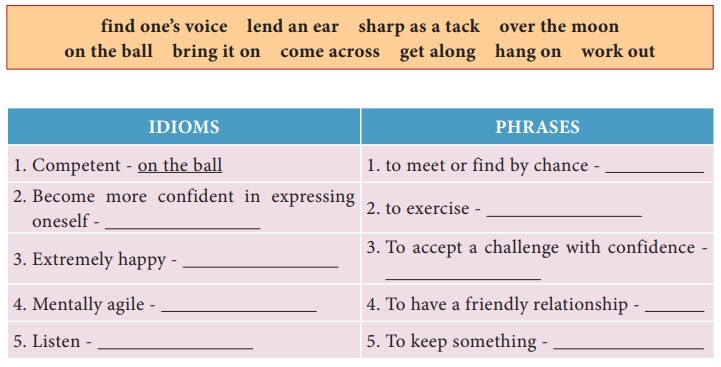
IDIOMS – Answer
l. Competent – on the ball
2. Become more confident in expressing oneself – find one’s voice
3. Extremely happy – over the moon
4. To accept a challenge with confidence – bring it on
5. Listen – lend an ear
PHRASAL VERBS – Answer
1. io meet or find by chance – come across
2. to exercise – work out
3. Mentally agile – sharp as a tack
4. To have a friendly relationship – get along
5. To keep something – hang on
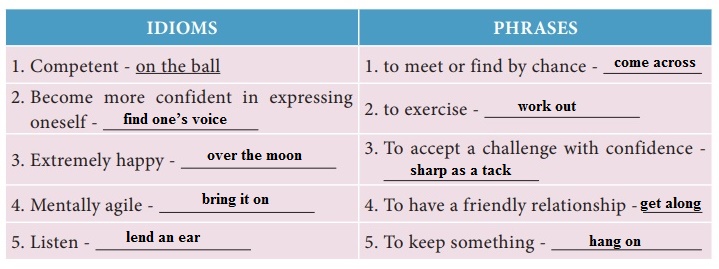
E. Read the given sentences carefully and fill in with appropriate phrasal verbs. Choose them from the help box.

1. The airhostess instructed the passengers to wear the seat belts during the take off
2. Venkat felt happy to get along with the neighbours in the new locality.
3. There will be a shut down next week in the office.
4. Doing warm up every day in the morning keeps one healthy.
5. The mother instructed the maid to look after the child carefully.
F. Read the given passage carefully and fill in the blanks with suitable phrasal verbs from the help box.

Riya is a young dancer who feels contented and satisfied with herself. Let’s hear from her.
Hi, everyone! I am Riya. I suppose I’m really lucky because I don’t put on weight easily. I never in work out the gym and the only time I stretch out is when I need something from the top shelf. I tried aerobics several times but I couldn’t keep up with the others. I take my pet for a walk thrice a day though, and that helps to burn off the calories. I usually watch what I eat but I sometimes binge on icecream.
My sister Diya, is a real fitness fanatic. Before she works out she warms up every day with push ups, sit ups, stretches and a jog around the park. She says it’s important to build up good levels of strength and stamina. I don’t want to overdo it though. A fitness regime like hers would tire me out!
Listening
G. *Listen to the passage read by the teacher and say whether the given statement is true or false.
1. Preethi Srinivasan is a former cricketer from Tamil Nadu. – True
2. At the age of seventeen, she captained the Indian Women’s cricket team. – False
(At the age of seventeen, she captained the Tamilnadu women’s under-19 cricket team.)
3. Preethi Srinivasan was not only a cricketer but also a runner. – True
4. Preethi’s own trauma inspired her to create SoulFree, a foundation for those suffering from mental illness. – False
(for those who cope with disabilities related to spinal cord injuries)
5. Preethi received the Kalpana Chawla Award for Courage and Daring Enterprise. – True
Speaking
Story Telling
Storytelling is an art which involves planning, research and skill. A good storyteller makes decisions ahead that drive their stories forward, engage their audience and relate information important to the telling of the story.
Techniques and Presentation skills
There are certain techniques that help narrate a story perfectly.
· Remember and recall the plot.
· Create story frame to remember the key events
· Self-narrate the story as a rehearsal
· Change the volume, pitch and tempo of your voice to make the narration effective.
· Use appropriate facial expressions and gestures.
· Include questions and answer them during the narration.
· Retain focus and maintain concentration on what you are narrating
· Sustain eye contact and grab attention of the audience.
Storytelling is a good exercise to practise in the classroom as it enhances the creativity of students and also brings out their potential in narrating a story interestingly.
H. Read the clues given below and develop your story. Narrate your story to the class.
Robert Bruce – King – lying on the ground in a dejected mood – failed to defeat his enemies – was thinking of giving up the attempt – saw a spider falling down from the ceiling – the ceiling far away – wondered how it would get there – the spider fell back again – again it tried – again it fell – it made nine such attempts – no success – climbed up once more – at last succeeded in reaching the roof – Bruce imitated its example – he too tried once again – was successful.
Answer:
Once there lived a king named Robert Bruce. He was lying on the ground in a dejected mood, since he failed to defeat his enemies. He was thinking of giving up. his attempt. At that time, he saw a spider falling down from the ceiling which was far away. He wondered how it could get there. The spider tried again, but it fell back again. It did not lose hope. It tried again but it fell down- again. It made nine such attempts. It did not succeed. It climbed up once more and at last succeeded in reaching the roof. Bruce was surprised to see this. He was inspired and motivated by its efforts. Once again, he tried to defeat his enemies. This time he succeeded in his effort.
I. Develop a story with the given pictures and narrate it to your class. Your story must have a plot and vivid details.
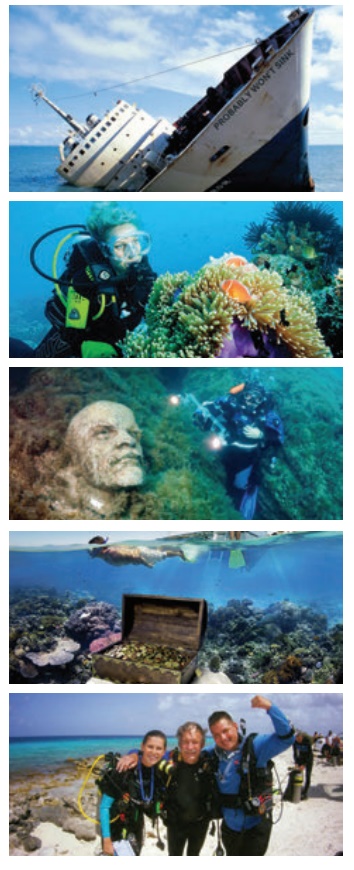
Answer
Once a ship got wrecked. The ship had a lot of treasure. So some crew members wanted to get the treasure. They went inside the sea. They saw the coral reef and the other wealths of the sea. They saw some fossils there. Finally they reached the treasure. They grabbed it and returned to the shore victoriously.
Reading
I. Read the data below and answer the following questions.

Choose the correct answer.
1. What is the data about?
a. women empowerment
b. women power
c. women at work
d. women at home
2. Identify the three jobs where the same percentage of women work.

Ans: b
3. In which field of work is women’s involvement the second highest?
a. Logistics stores
b. Home maker
c. Medicine
d. Administration/Human resource
4. Percentage of women working in finance is the same as
a. Home maker
b. Information Technology
c. Technical Field
d. Administration/Human Resources
5. What is the difference between the percentage of women working in logistics and Medicine?
a. 8
b. 11
c. 13
d. 5
Writing
Slogan
A slogan is usually a short phrase that is easy and catchy to remember. They are often used in advertisements and by political parties or organizations who expect people to remember what they are selling. The words used in a slogan are simple, relevant, attractive and brief.
Example:

J. Read the given slogans and match them appropriately with their theme.
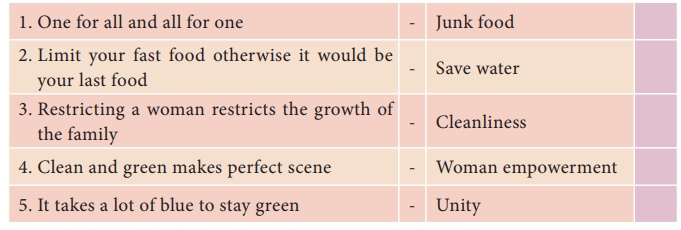
Answer
l. One for all and all for one :- Unity
2. Limit your fast food otherwise it would be your last food :- Junk food
3. Restricting a woman restricts the growth of the family :- Woman empowerment
4. Clean and green makes perfect scene :- Cleanliness
5. It takes a lot of blue to stay green :- Save water
K. Look at the images of familiar advertisements given below. Identify the products and try to frame your own slogans for each one of them.
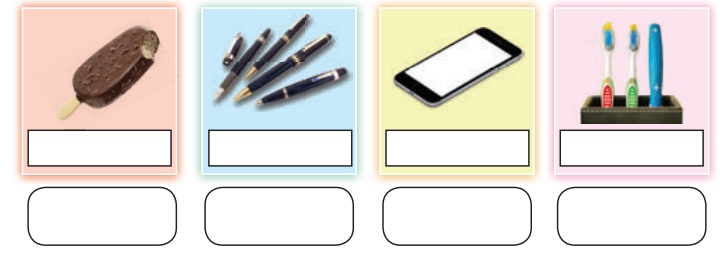
Ice Cream: I taste you! You melt me!
Pens: The World’s most wanted pen
Mobile phone: Empowering people Expanding Possibilities
Tooth brush: Designed for every smile
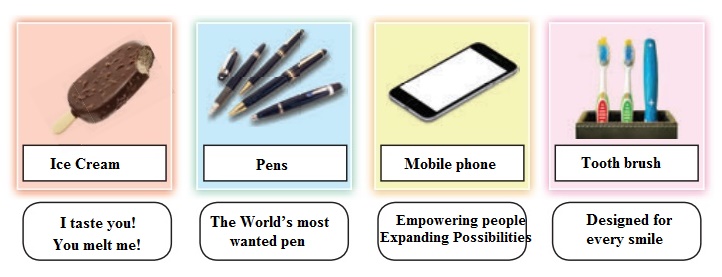
L. Look at the pictures given below and frame your own slogans:


Letter Writing:
A letter is an important means of communication which could be personal or official. Letters are broadly classified into two types: Formal and Informal letter. In Class IX you have studied both the types – formal and informal.
Now let us learn to write a letter ordering goods and how to write a complaint for any damage or any other problem noticed after receiving the goods.
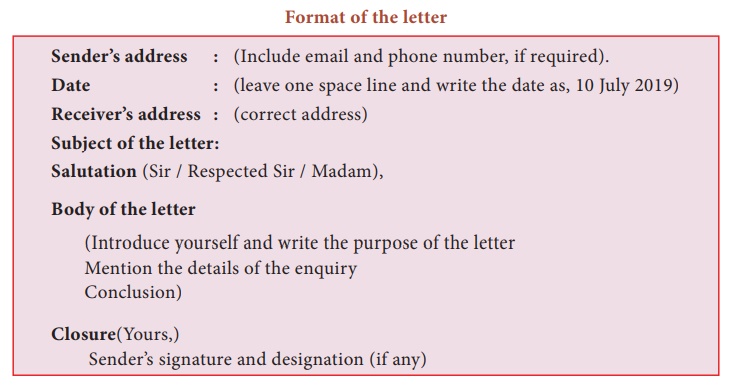
Model of the letter:
Letter ordering things.
Ms. Deepa an NGO writes a letter to the wholesale book shop dealer, placing order for 100 copies of medium size English Oxford Dictionary.
Ms. Deepa,
NGO (Nallam Trust),
Kalapet village,
Nagappattinam District.
13 May 2019
The Proprietor,
NIZHAL BOOK SHOP,
Chennai – 600 001.
Sir / Madam,
Subject: Order for English Oxford Dictionaries – Reg.
On reading the discount provided by your shop in the advertisement of yesterday’s newspaper, I would like to place an order for 100 copies of medium sized English Oxford Dictionary in your shop. I need the copies within a week. So, let me know the estimation for the bulk order placed, as early as possible.
Thank you,
Yours faithfully,
Deepa.B
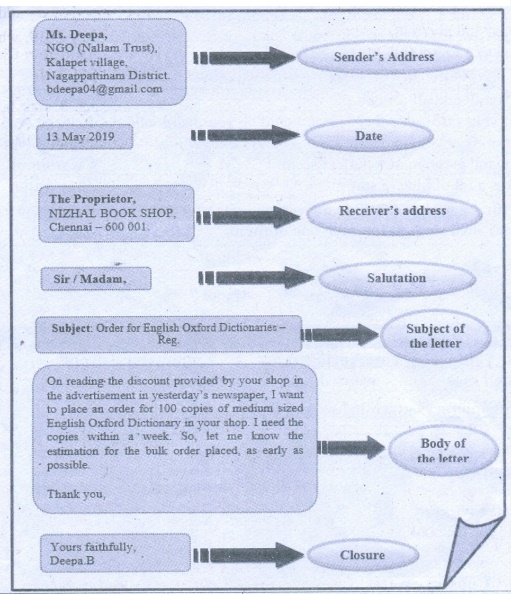
Letter of complaint 1
After receiving the order, Deepa finds that some of the dictionaries are damaged. So, she writes the following letter of complaint.
Ms. Deepa,
NGO (Nallam Trust),
Kalapet village,
Nagappattinam District.
20 May 2019
The Proprietor,
NIZHAL BOOK SHOP,
Chennai – 600 001.
Sir / Madam,
Subject: Complaint about damaged dictionaries – Reg.
On receiving the order of 100 copies of English Oxford Dictionary from your shop, I found that around 25 copies of them were damaged. In some copies the pages are missing and in some more copies the pages are not in order. So, duly accept my complaint and replace the damaged copies. Kindly, check the returned copies and replace them accordingly.
Thank you,
Yours faithfully,
Deepa.B
Letter of complaint 2
Mr. Srinath lost his bag in an over crowed train. The following is the letter of complaint which he writes to the railway police force.
Srinath B,
No.24, I cross, Pon Nagar,
Chengalpettu-10.
25 July 2019
The Commissioner of Railway Police,
A-2 Police station, D-Nagar,
Chengalpettu-02.
Respected Madam,
Subject: Complaint about status of the lost certificates – Reg.
I am a graduate seeking employment, residing in the above mentioned address. I lost my certificates on 15th July 2019, while I was returning home in a local train from Chengalpattu. As the train was over crowded, I placed my bag on the rack above. When I was about to get off, I noticed that my bag was missing. I was helpless and filed a complaint with the Railway Police. I have given all the details in the complaint letter on the same day. So far I have not received any further response. I request you to take immediate action in this regard.
Thank you,
Yours faithfully,
Srinath B.
M. Exercise:
1. Imagine that you have parked your vehicle (two-wheeler)/ bicycle inside the school premises. You find it missing in the evening. Write a complaint to the head of the school regarding this issue.
M. Malar,
X standard A Section,
Govt. Hr. See. School,
Karur.
20 May 2019.
The Headmaster,
Govt. Hr. Sec. School,
Karur.
Subject: complant about the missing cycle – Reg Respected
Sir/ Madam,
Yesterday . I placed my bi-cycle just in our school parking area. In the evening I was shocked to see that the bicycle was not there, though it was locked properly. I searched every nook and comer. But it was in vain. It was a ‘Hero’ bi-cycle and the Number is HO 5343IL. I shall be highly obliged and thankful, if you kindly take steps to find out my bi-cycle.
Thank you,
Yours faithfully.
Malar M
2. Write a complaint to the officer of the PWD department to take immediate actions of maintaining cleanliness in the Children’s Park in your locality.
Jennifer. P,
Thillai Nagar,
Trichy.
25 July 2019.
Chief Engineer,
PWD Department,
Trichy.
Subject: Complaint about the cleanliness of the childrens park – regarding
Respected Sir,
There is a serious issue in our area that needs your urgent attention. There has been no maintenance in our area children’s park, for the past three months. Due to lack of cleanliness, children in our area cannot enjoy it. Moreover the park is also used for some anti-social activities by the local persons.
Kindly take necessary steps to solve this issue as soon as possible.
Thank you,
Yours faithfully.
Jennifer. P
3. Write a letter to the manager of a famous daily, ordering subscription for your school library.
Kamila R,
School Pupil Leader,
Govt. Hr. Sec. School, •
Ariyalur.
25 July 2019
The Manager,
The Hindu,
P.B.No. 234,
Trichy.
Subject: Supply of paper for school library
Respected Sir/Madam,
I am the School Pupil Leader of Govt. Hr. Sec. School, Ariyalur. We need your daily newspaper for our school library. We want 1 copy of Tamil edition and 2 copies English edition newspaper. I want to know the subscription details for our need. Please send us the details and send the dailies from next month onwards.
Thank you.
Kamila R
Grammar
The term, ‘Tense’ denotes the time of action. They show when the work is done.
The English Tenses are :
1. Past
2. Present
3. Future
1. Present Tense
Forms and Uses of the Simple Present Tense
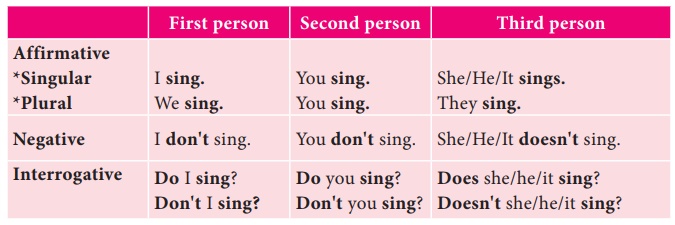
Note: Except for third person plural affirmative, the structure does not change for negative forms.
Now try framing plural negative and interrogative negative sentences.
Uses
· to express universal truths, facts, customs
· to express habitual, routine actions
· to express a permanent state
· in exclamatory sentences
· in subordinate clauses beginning with if and when
· in imperative sentences
· to indicate a planned future action or series of actions when they refer to a journey
· in running commentaries
· to introduce quotations
e.g. Mahatma Gandhi says, “Be the change you want to see in the world.”
Forms and Uses of Present Continuous Tense

Note: The contracted form of ‘am not’ is aren’t and the contracted form of are not is also aren’t.
Uses
❖ The Present Continuous Tense is used for an action that is in progress at the time of speaking.
❖ It is used for an action that is in progress and will continue in future.
e.g. Paul is learning English.
❖ It is used to denote an action that is planned to take place in the near future e.g. Yazhini is meeting the Prime Minister tomorrow.
❖ It is used along with adverbs such as ‘always, constantly, repeatedly’ etc. to express an action that has become a habit by doing it over and over again.
e.g. Sumithra is always asking questions.
Note: Verbs of perception and some other verbs are not generally used in the present continuous tense, for example see, smell, hear, taste, know, understand, hate, like, want, wish, etc.
Forms and Uses of Present Perfect Tense

❖ For an action which began in the past and is in progress now.
e.g. Bharani has called the fire man and they are on their way.
❖ To express an action that has been recently completed
❖ With adverbs like already, recently, yet,
❖ To express an action that began in past and is still continues up to the present
e.g. She has lived in this house for five years.
Note: We do not use adverbs of time denoting the past tense in Present Perfect Tense.
e.g. Father has returned from Vellore yesterday. (This sentence is wrong.) Father has returned from Vellore.
Forms and Uses of Present Perfect Continuous Tense

Note: Since is used for a point of time; For is used for a period of time
Uses
❖ To express an action which began at some time in the past and is still continuing and may extend into the future.
e.g. She has been studying since morning.
❖ To express an action in a sentence which begins with for how long or since when
❖ To express an action that began sometime in the past and has been just completed. However, its result is visible in the present.
e.g. I have been working on this project for five hours and I am tired now.
A. Complete the sentences in present tense forms.
1. Saravanan always goes (go) for a walk in the morning.
2. We gather (gather) here for a meeting and the chair person is yet to arrive.
3. Aruna has eagerly been waiting (wait) to meet her friend since morning.
4. Sheeba moves/will move (move) to a new house next week.
5. Naseera attends (attend) music classes regularly.
6. Ilakiya and Adhira enjoy (enjoy) each other’s company very much.
7. Mani has been working (work) in this school for five years.
8. It is pouring (pour) outside now.
2. Past Tense
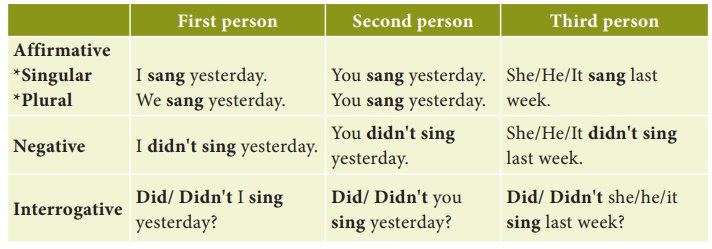
Forms and uses of the Simple Past Tense Uses
❖ To indicate an action that was completed in the past. Generally the adverbials of past time are used; sometimes without adverbials of time for an activity done in the past
❖ To express a habitual or regular action only in the past; It can also be expressed by using ‘used to’
❖ In conditional clauses
❖ In the indirect form of speech
❖ To express two actions, where the first action leads instantly to the second action
e.g. When the meeting ended, the staff members came out.
Forms and Uses of Past Continuous Tense
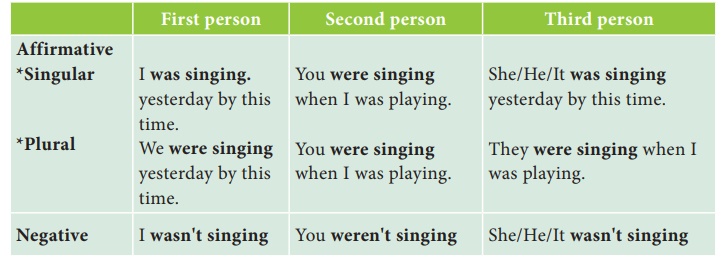
Uses
❖ To express a state or an action that was continuing at a certain point of time in the past. It had begun before that point and was probably continuing after it. We use adverbials of time.
e.g. We were decorating the house for the birthday party in the morning.
❖ To express an action that was in progress in the past
❖ To express an action in progress at some point of time in the past when another event took place
e.g. She was cooking when the guests arrived.
❖ To describe two or more actions continuing at the same time
e.g. While I was watching T.V., he was sleeping.
❖ To indicate a frequently repeated action or persistent habit in the past
e.g. Nithish was constantly complaining about something or the other.
Forms and Uses of Past Perfect Tense

Uses
❖ For an action that had been completed before another action began in the past
e.g. He had appealed to the manager for a week’s leave before I reached.
❖ To describe an action or event which has been completed before some point of time.
e.g. By 11 a.m. all the students had left the school campus after the Independence Day celebration.
❖ To describe an action in the past which became the cause of another action
❖ To describe an action in the past using the time adverbials such as already, since, before, etc.
❖ To express an unfulfilled action in the past and unfulfilled wish in the past.
e.g. If he had informed her, she would have waited for him.
I wish I had accepted the job.
Forms and Uses of Past Perfect Continuous Tense.

Uses
❖ to describe an action in the past that had begun and had been going on for sometime before another action took place in the past
e.g. Mahi and Ragav had been arguing with each other when their mom arrived.
❖ to describe an action that had been going on for some time in the past
e.g. The students had been practicing for the last couple of weeks.
B. Complete the sentences in past tense forms.
1. I went (go) to her place on foot.
2. The children were playing (play) in the ground when the teacher arrived.
3. They were requesting (request) him when the manager arrived.
4. If you had worked (work) hard, you would have won the relay match
5. Joanna and Joy had already left (leave) for Ooty, when the others reached the station.
6. We all sang (sing) in the choir last week.
7. Nancy had always been asking (ask) for help.
8. The office goers waited (wait) for the train.
3. Future Tense
Future time in English can be expressed in the following ways:
(i) Simple Present Tense
e.g. She leaves this evening.
(ii) Present Continuous Tense
e.g.We are meeting the Prime Minister tomorrow.
(iii) be about to
e.g. The train is about to leave the station.
(iv) be going to.
e.g. Prices are going to rise.
by denoting the Principal clause of a conditional sentence.
e.g. If she works hard, she will get a scholarship.
Forms and Uses of Simple Future Tense.

Uses
❖ Shall is used with the second and the third persons to express determination, promise, intention, etc.
❖ Shall is used with the first person to express an offer or suggestion
❖ Will is used with the first person to express willingness, determination, etc
❖ The simple future is used to express the speaker’s opinion, for something to be done in the future. We use verbs such believe, know, suppose, think, etc. We also use adverbs such as perhaps, possibly, surely, etc.
❖ It is used for an action that is yet to take place
Forms and Uses of Future Continuous Tense

Uses
❖ The Future Continuous Tense is used to express an action that will be in progress at a given time in future or in the normal course
e.g. We will be playing from 5 p.m. to 6 p.m The lift will be running in the month of May
The Future Perfect Tense.
Uses
❖ The Future Perfect expresses an action that is expected to be completed by a certain time in the future.
e.g. We will have completed our work by the time our sisters arrive.
❖ It is used to express the speaker’s belief that something has taken place. In such sentences it does not express the future.
“You will have discussed the plans how to celebrate the function”, said my mother.
❖ It is also used for an action which at a given future time will be in the past.
e.g. In two years’ time, I shall have earned my degree.
The Future Perfect Continuous Tense.
Uses
❖ The Future Perfect Continuous Tense is used to express an action that will have been going on at or before some point of time in the future.
By next June, I shall have been completing my studies.
Note: The less frequently used tense forms are Past Perfect Continuous Tense and Future Perfect Continuous Tense.
C. Fill in the blanks using the verbs in the brackets in the future form.
1. We shall not go to the market, in case it rains. (go)
2. Keerthi will have done his work by next week.(do)
3. The peon will have rung the bell by the time I reach the school.(ring)
4. I shall visit my sister’s house next April if I go to Uttarkhand. (visit)
5. If you listen carefully, you will understand my point. (understand)
6. By next year, I shall have lived in Chennai for fifteen years. (live)
7. The new edition of this book will come out shortly. (come)
8. She hopes you will help her. (help)
D. Underline the verbs and identify the tense forms.
1. I am working hard day and night. Persent Continuous Tense
2. The Moon revolves around the Earth. Simple Present Tense
3. Were the milk men milking the cow? Past Continuous Tense
4. He received your messages last night. Simple Past Tense
5. I have been ill for a couple of days. Present Perfect Tense
E In the following passage, some words are missing. Choose the correct words from the given options to complete the passage.
Raghav (a) is born in a middle class family. He is a (b) school going boy of 8. His mother (c) works as a software engineer in an MNC. (d) Drawing is his favourite hobby. He (e) won the first prize in school level competition for drawing last week. He (f) started drawing at the age of 3. His mother (g) hopes he (h) will become a great painter in future.
(a) (i) will be born (ii) is born (iii) born (iv) has born
(b) (i) school-going (ii) going to school (iii) school coming (iv) school gone
(c) (i) working (ii)works (iii) has worked (iv)will work
(d) (i) drawn (ii) had drawn (iii)drawing (iv) having drawn
(e) (i) win (ii) was winning (iii) wins (iv)won
(f) (i) was starting (ii) starting (iii) started (iv) is starting
(g) (i) hoped (ii)hoping (iii) hopes (iv) has hoped
(h) (i) will become (ii) becomes (iii) would become (iv)will be becoming
F. The following passage has not been edited. There is one error in the tense of the verb in each line. Write the wrong word as well as the correct word in the given place. One is done for you.
When Anand reach Arun’s place, his – reached
friends have arrived already. Arun – had arrived
introduces Anand to them. Arun’s brother – introduced
buy some snacks from the market. – bought
Arun serving it to all his friends. Then – served
they all sat together to planning their holidays. – to plan
Arun have a cottage in Ooty, so – has
they all plan to go to Ooty during the holidays. – planned
“Would we have a good time?, asked Arun. – shall
They all cheerfully say, “Yes!” – said
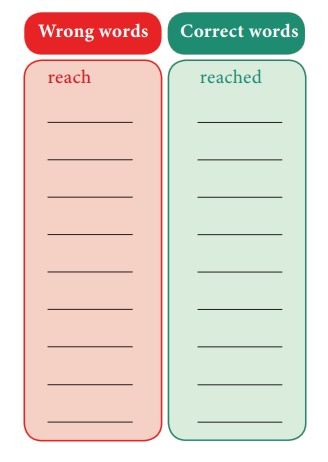
G. Read the story and rewrite it using the simple past tense.
Juno the elephant is lonely and tries to make friends with the other animals in the forest. But, the other animals refuse to play with Juno because of his size. One day, all the animals are running away from Dera the tiger who is eating everyone he finds. Juno goes and gives Dera a swift kick. Dera immediately runs away. Juno is now everyone’s friend.
Answer
Juno the elephant was lonely and tried to make friends with the other animals in the forest. But; the other animals refused to play with Juno, because of his size. One day, all the animals ran away from Dera the tiger, who ate everyone he found. Juno went and gave Dera a swift kick. Dera immediately ran away. Juno was now everyone’s friend.
H. Read the situations given and frame two suitable sentences in the appropriate form of the tenses.
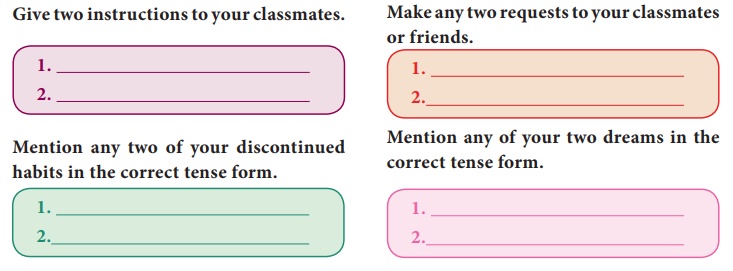
Give two instructions to your classmates.
1. Don ’t write on the wdll.
2. Be punctual.
Mention any two of your discontinued habits in the correct tense form.
1.I used to quarrel with my friends.
2. I gave up drinking coffee.
Make any two requests to your classmates or friends.
1. Please give me your record.
2. Kindly go with me to the library.
Mention any of your two dreams in the correct tense form.
1. I dream that I will buy a car.
2. I always dream of becoming a millionaire.
